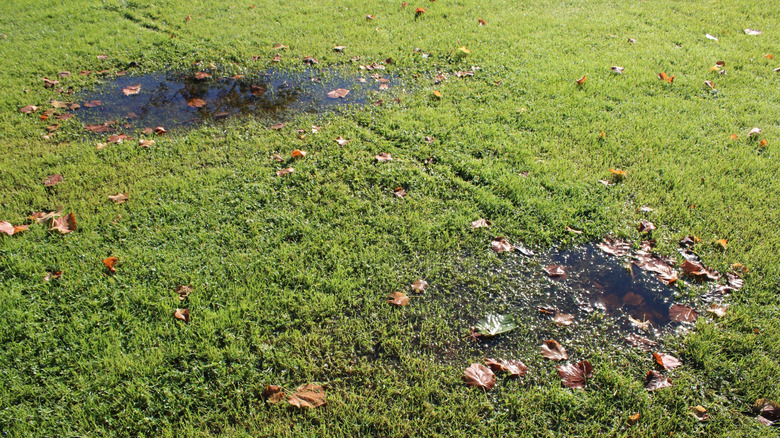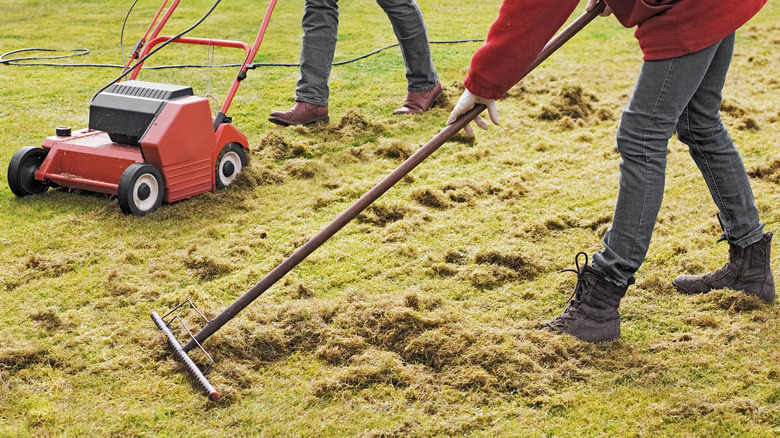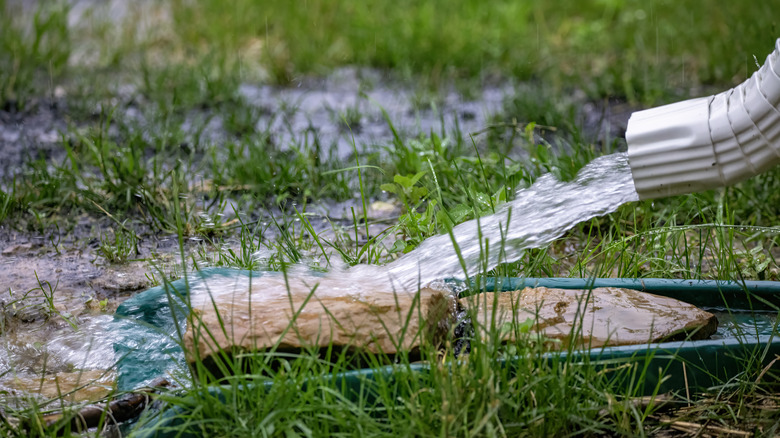The Easiest Way To Remove Standing Water From Your Yard (Without Hiring A Pro)
After some dry weather, seeing rain in the forecast is a big relief. However, when that rain leaves you with a waterlogged lawn that needs fixing, you might prefer the drier weather. You don't have to simply accept the wet spots and puddles in the yard, though. Removing standing water that's a consistent problem doesn't always require hiring a pro and putting up with the expense and other disadvantages of hiring a professional lawn care company. You can try a relatively easy DIY fix to take care of the standing water problem on your own.
Consider dethatching and aerating your lawn to try to take care of this problem. This solution tends to work well when the water isn't sinking into the soil like it should. Thatch, which is a layer of organic plant material that sits between the grass and the soil, eventually breaks down and contributes organic materials to the soil. However, if the layer is slow to break down and becomes too thick, it could prevent water from soaking into the soil. Aerating at the same time reduces soil compaction issues that can cause standing water.
Allowing water to collect in the yard can be dangerous for your property. If the water is near your home's foundation, the excess moisture can erode the soil around the foundation, causing instability, and it can pass through the porous concrete walls of the foundation, causing moisture damage in the basement. The excess puddles can kill your grass or give mosquitos a breeding ground. Prevent these problems from occurring by learning more about how to dethatch and aerate the area with the water issues.
How to dethatch and aerate your lawn to encourage water drainage
Although you can dethatch and aerate your yard by hand, most people will prefer using power equipment. Manual dethatching can be tiring, physical work especially if you have a large space. However, if you're just going to dethatch a small area with standing water, doing it by hand is worth considering. You can use a dethatching rake, which has short, curved blades that slice through the thatch and help you pull it up. Mow the lawn to half the normal height before dethatching. Once you finish, you can use a leaf rake to collect the thatch and remove it.
Aerating your lawn by hand is also possible in a small area. You can use a garden fork that has up to five tines. Press the tines into the ground and wiggle the garden fork back and forth to widen the holes slightly. Another option is a manual core aerator, which allows you to pull soil cores out of the ground one at a time.
If the area with standing water is larger or you don't want to work with manual tools, you can rent power tools. You can rent a power dethatcher (also called a power rake) for around $40 to $60 for four hours. Renting a power aerator will cost around $55 to $75 for four hours. Explain what you're trying to do with these tools, and the rental company can set up the machines for your needs. You might need to reseed bare spots after doing the work, whether you take the manual or with power tool approach.
Make sure the standing water doesn't have a correctable cause
Before you go through the process of dethatching and aerating, you may want to be sure that the problem with standing water relates to excess thatch and compacted soil. A common cause of standing water and a patchy lawn relates to your plumbing, sewer (or septic) system, or underground sprinklers. You may also have issues with clogged gutters and improperly aimed downspouts. You might still need to aerate and dethatch to help repair the area with constant moisture, but you should fix the underlying problem, too.
If the standing water relates to a clogged sewer line or problem with the septic system, it probably will have an unpleasant odor. If the spot relates to a sewer leak, you might have spots of oddly bright green grass near the puddles, as the grass is using the sewage as organic material to help it grow. Leaking underground sprinklers may show up as bubbling or tricking water out of a sprinkler head or an increased water bill that has no easily identifiable source.
If you have clogs in your gutters or downspouts, water might spill over the top and collect near the home, creating puddles and constant moisture. If properly functioning downspouts are not aimed properly or do not extend far enough away from the house, the water could flow into a low spot and cause standing water. Use a gutter-cleaning tool or pull debris by hand out of the gutters to unclog them. Alternatively, extend your downspouts as needed to move water farther from the home.


